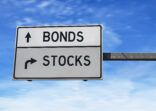As US Treasury yields extend their decline, it has sparked a rally in almost all other asset classes including stocks, credit and emerging markets.
Investors are now anticipating more gains across the board with interest rate cuts coming closer into view.
This recent rally comes after a year of whipsaw trading in the long-end of the US Treasury market as investors try to find an equilibrium for long term rates – a key metric for valuing all asset classes.
Although rates have fluctuated between 3% and 5% year-to-date, Amundi’s strategists expect the US 10-year to settle at the lower end of this range.
Group chief investment officer Vincent Mortier and Monica Defend, head of the Amundi investment institute, said in a recent press conference that they expect lower rates because they are anticipating the US economy to decelerate noticeably.
Mortier said: “Market participants are betting on lower rates, based on inflation deaccelerating.”
But he stressed that the Fed would cut rates not because growth is slowing dramatically, but mostly because there is no inflationary issue.
“So the risk to this scenario that I think the markets are overlooking, is any bad surprise on inflation,” he said.
“We have seen that any good surprise has been very well received, and sometimes super well received. [But], I don’t think the market is prepared if inflation is changing course, or if inflation is becoming less easy to predict.”
Fixed income markets could be subject to another bout of volatility if inflation unexpectedly returns, he warned.

However, any volatility will be an opportunity for market participants with a clear idea about what the fair value of the US 10-year treasury note is, he added.
Depending on what an investor’s fair value estimate of the US 10-year note is, Mortier suggested investors take the opportunity to navigate around the volatility based on it.
He said: “Maybe before going to 3.7% we might revisit 5%, we might also go to 3%. We don’t know. We think 3.7% is a fair value and a target.”
Defend stressed that their fair value estimate is a result of their own expectations of growth, inflation, oil prices, labour market dynamics and balance sheets.
She said: “We expect the United States to enter a mild recession in the first half of the year.
“It will be caused by financial conditions tightening. Eventually the tightening in financing conditions is going to start to bite the consumer and enterprises.”
So far, the US economy has proven to be resilient despite being subject to the quickest bout of interest rate hikes seen in decades.
But as inflation falls and interest rates remain high, the Fed’s monetary policy starts to become more and more restrictive as real rates rise.
Mortier said: “We are convinced that the US economy – that will barely grow – cannot support real rates of more than 1%.”
“We see that when real rates are at 1.5% or 2% it is becoming a very serious issue for the US economy.”
Mortier also warned that another risk that the market is underestimating is related to rising delinquencies in US consumer credit.
He said: “I think the market has been accustomed to a level of credit risk, but what you are seeing more and more, is despite full employment in the US, delinquencies are on the rise in consumer credit. That is a worry.”

















